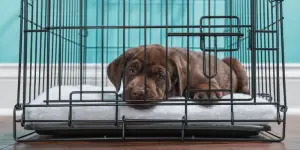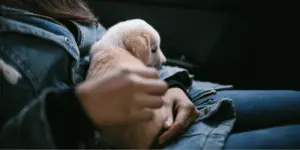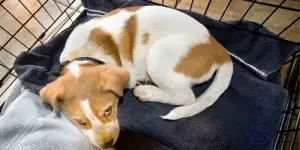
Puppy Zoomies – Everything You Need to Know About Dog Hyperactivity
- Written by Joshua Gordon
- Last updated
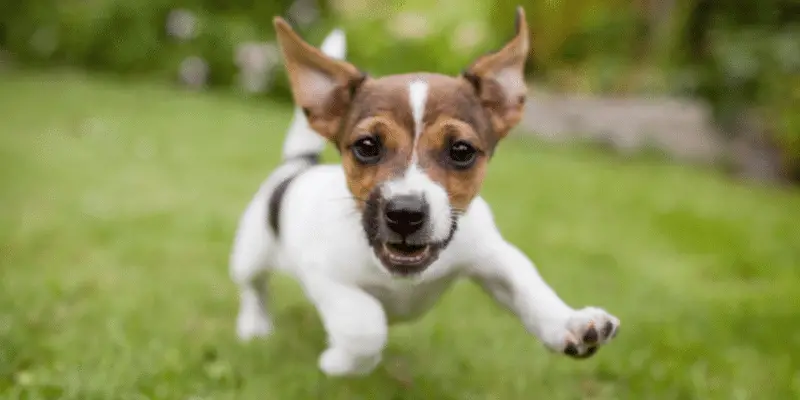
Key takeaways
- Puppy ‘zoomies’ are outbursts of energy that can include running, jumping, yelping and snapping.
- ‘Zoomies’ or hyperactivity typically last between 1 – 10 minutes.
- The main cause of ‘zoomies’ is pent-up energy.
- ‘Zoomies’ commonly happen after situations of excitement but also stress.
- Manage ‘Zoomies’ with regular mental stimulation, exercise, and patience.
In this article
Puppy zoomies – What are they?
zoomies refer to unexpected frantic bursts of energy. There’s usually no warning: one minute your dog is calm as can be, the next, they’re zipping around the room like a bouncy ball.
Watching your dog suddenly speed around in a circle can be quite an amusing yet bizarre moment. Most of the time, that sudden flurry of energy isn’t a cause for concern.
However, this type of hyperactivity can be pretty confusing for us dog owners, and occasionally it can be an indicator of an underlying behavioural issue.
What are dog zoomies?
Dog zoomies refer to unexpected frantic bursts of energy. There’s usually no warning: one minute your dog is calm as can be, the next, they’re zipping around the room like a bouncy ball!

Ask the Vet - What are puppy zoomies - is it normal?
"Puppy ‘zoomies’ are outbursts of energy that can include running, jumping, yelping and snapping. These can occur at any time but seem to happen most often in the evening. When they’re happening, try to distract your pup with something to do like a tug toy. Don’t punish them and try not to run away or scream, which can make the ‘game’ more exciting for them"
- Dr Linda Simon MVB MRCVS
FRAPs definition
Zoomies are also known as FRAPS, which means Frenetic Random Activity Periods. If you’ve ever seen your dog suddenly sprint around, often in a circle, that’s a clear sign of the zoomies.
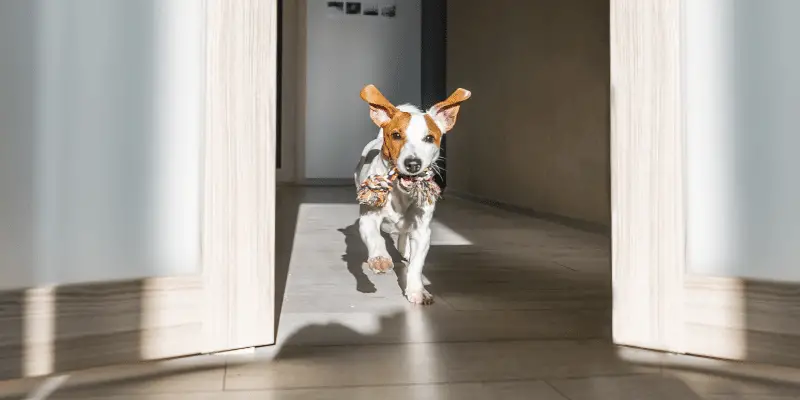
Why do dogs get zoomies?
Dogs get the zoomies when they have too much energy. All that hyperactivity needs to go somewhere, so zoomies provide a way for dogs to let off some steam. Most dogs get FRAPs during play or after a bath, but sometimes a stressful situation can be a trigger.
Additionally, certain times of the day can set off a case of the zoomies, such as the evenings just before bedtime.
How long do puppy zoomies last?
Zoomies usually don’t last for long periods, typically a few minutes at most. However, some dogs might have the zoomies for longer, occasionally over 10 minutes.
As long as your dog isn’t hurting themselves, it’s best to just wait out a case of the zoomies. Your dog will eventually grow tired and flop down to the floor for a well-earned rest.
What causes zoomies?
The main cause of zoomies in dogs is pent up energy. It’s not quite clear why dogs engage in this type of behaviour when they’re feeling restless. However, it’s completely normal and rarely a cause for concern.
Additionally, random hyperactive periods aren’t just limited to canines. They also occur in other animals, including cats, horses, goats, ferrets, bears, and even elephants.
Common times dogs get zoomies
While zoomies can strike on any day at any time, some scenarios are more likely to trigger hyperactivity in dogs.
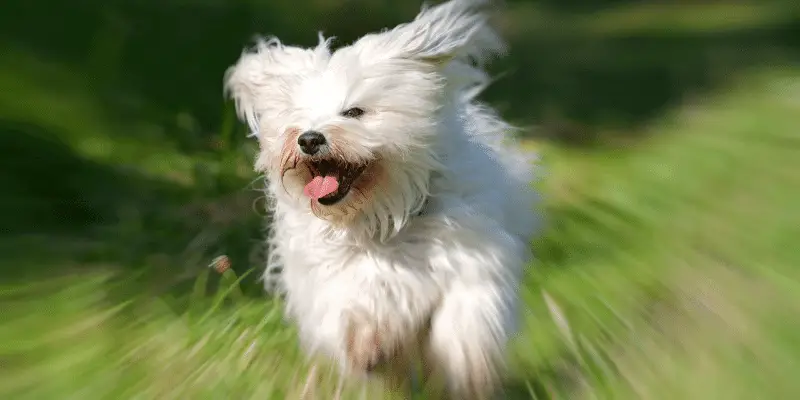
After an uncomfortable or stressful situation
Not all cases of the zoomies are due to happy excitement. They can also be due to anxiety from an uncomfortable or stressful situation, such as being at the vet’s.
If your dog is nervous but appears excited at the same time, their facial muscles and body muscles will look tense. Additionally, if they’re wagging their tail, they won’t move their whole body.
After a bath or being groomed
Most dogs dislike baths and being groomed, so it’s not uncommon for dogs to roll, shake, and zoom around just after either scenario.
Canines do this as a way to rid themselves of the new smell and to help dry off.

After a walk
Dogs being excited after a walk seems a little odd, as you’d assume it would be the other way around. However, a case of the zoomies once a walk is over isn’t out of the ordinary. Read this article if your puppy hasn’t been out for a walk yet.
Your pooch is reacting to the way they’re feeling, which could be frustration or even relief that their walk has come to an end.
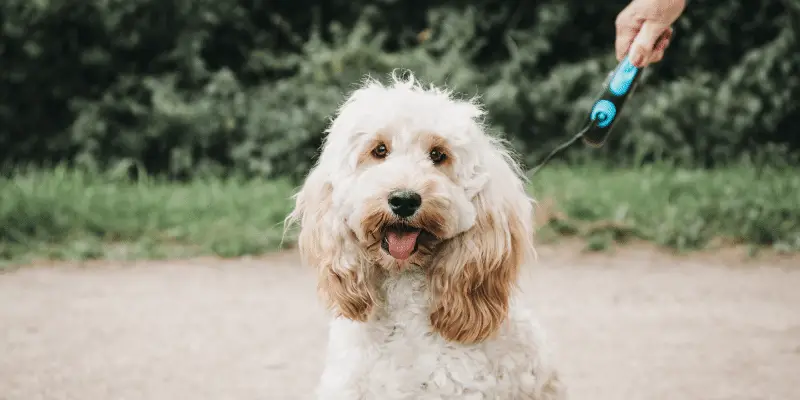
When playing
Zoomies are most frequently seen when a dog is playing, even more so if their favourite person is involved. That excess energy needs to be let off, so what better way to do just that than race around the room like a roadrunner!
After a long car ride
Being confined to a car for long periods can be quite stressful for dogs when not properly set up in the right car crate, particularly as they have no way to release any excess energy. Once out of the car, your dog might dart around in circles in order to expel some of that energy.
Read our guide on how to safely travel with your dog in a car.
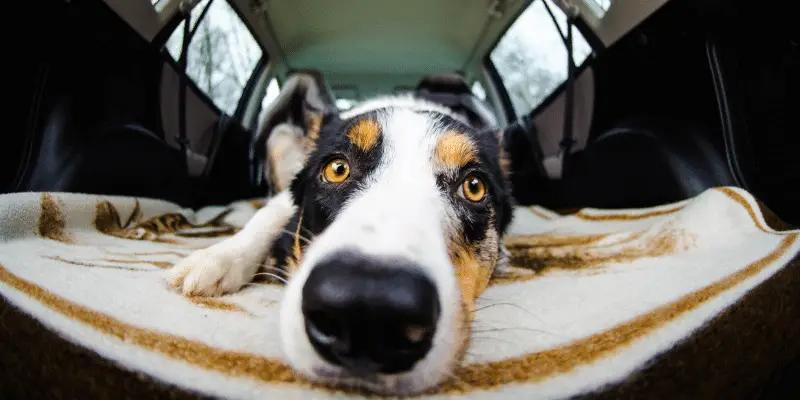
After removing a leash, harness, or collar
Harnesses, leashes, and collars can be a little uncomfortable for dogs to wear. After removing either, you might spot your pup darting across the room due to relief or to properly stretch their legs.
What Should You Do When Your Dog Gets the Zoomies?
Zoomies are perfectly natural, so just let your dog tire themselves out. If you’re worried about your pup hurting themselves or scratching up your furniture, try and redirect their attention elsewhere.
For example, throw a toy in a safe area to encourage your dog to go in that direction. If your dog is good with recall, try and call their name to see if they will come to you.
However, most dogs won’t be able to stop mid-zoom. It’s best to wait it out and let them calm down themselves.
How to prevent zoomies
It’s difficult to prevent zoomies in dogs, particularly if they’re young. That said, there are a few things you can do to limit your dog’s excitement and decrease the chances of a zoomies spell.
Safely Managing FRAPs Dogs
If your dog is prone to FRAPs and you’re looking for ways to discourage that type of behaviour, the best methods are exercise and mental stimulation. When dogs have excess energy that they are unable to release, a case of zoomies is likely to follow.
By providing your dog with outlets to release that pent up energy, they’ll be less prone to a random explosion of hyperactivity. Better yet, after a vigorous walk and playing session, your pup will likely be too tired to do much other than sleep!
Additionally, make sure your dog can’t hurt themselves if they get overly excited. This might mean putting down rugs on slippery floors or putting away any objects that they could knock over in their path.
Mental stimulation
As we mentioned above, mental stimulation is one of the best ways to prevent zoomies in dogs. Toys, training, and play sessions provide your pooch with opportunities to challenge their mind.
Games like tug of war and fetch are particularly great options as they’re both fun and physically stimulating. Puzzle toys and chew toys are also beneficial as they keep your dog occupied even when you’re not able to play with them.
Exercise
Exercise is vital for your dog’s health as it keeps them in good shape and provides enrichment. It allows them to release pent up energy and explore new sights and sounds, which helps stave off zoomies!
Depending on your pup’s breed, age, and energy levels, their exercise needs will differ. However, most dogs require walks that last between 30 minutes to 2 hours each day.
A great way to track your dog’s fitness to ensure they’re getting enough exercise per day is to use a dog activity tracker. This device monitors your pup’s activity levels every day, eliminating the need for guesswork.
You can also record your dog’s fitness regime daily so you can check their progress, which is useful if they’re overweight.
Don’t chase
While it’s tempting to chase your dog mid-zoomies to try and get them to stop, especially if it’s at an inappropriate or dangerous time, this is actually counterintuitive. Chasing after your dog during a case of the zoomies will only encourage them to continue running.
Your pup will think you’re playing, which could result in them sprinting faster or further out of reach. Rather than run towards your pooch, run away from them (in the opposite direction of any roads or hazards) and use a positive voice.
It’s a good idea to have some treats or toys on hand to gain your dog’s interest. This will help persuade your pooch to follow you to investigate.
Watch for Any Compulsive Behaviours
Although zoomies are normal every now and again, if your pooch is constantly hyperactive after any situation, it could be a compulsive behaviour.
Make sure your dog is getting enough exercise and mental stimulation. If they appear restless, try increasing the duration of their walk or provide more challenging games and toys.
If you’ve exhausted all options and your dog is still overly energetic, you might want to consult your vet or speak to a canine behaviour specialist.
Aggression during dog zoomies
From time to time, your dog might nip or growl during a zoomies session. This isn’t usually done maliciously and is most likely because your dog got a bit caught up in the moment.
Provided your pooch isn’t biting or growling too aggressively, it isn’t typically a cause for concern. Try to redirect your pup’s attention using treats or toys to discourage biting.
If your dog is biting or growling excessively, this might be worth looking into with a canine behaviour specialist or something you should bring up with your vet.
Final thoughts
The zoomies are definitely one of the strangest behaviours dogs engage in, and now you know why they occur. While a sudden energy outburst from your pooch can take you by surprise, it’s completely natural.
It’s best to just let your dog have their moment to blow off some steam, so sit back and enjoy the show.
After a couple of minutes, they’ll act as if nothing has happened and you’ll probably get a few laughs out of it (hopefully, your belongings weren’t sent flying during the process!).
Provided your pooch isn’t biting or growling too aggressively, it isn’t typically a cause for concern. Try to redirect your pup’s attention using treats or toys to discourage biting.
If your dog is biting or growling excessively, this might be worth looking into with a canine behaviour specialist or something you should bring up with your vet.
FAQS
The zoomies aren’t over just yet! There’s still a little more you need to know about this odd behaviour in dogs, which we’ll be going over below.
Zoomies are completely normal and rarely something to be worried about. The majority of dogs, especially puppies, will experience a case of the zoomies at some point in their lives.
de FitBark, PitPat, PoochPlay, Tractive, and Whistle.
All dogs can get the zoomies, no matter their breed. They’re just as likely to occur in a Great Dane as they are in a Chihuahua!
However, canines with high energy levels like Border Collies may be more prone to FRAPs if they don’t receive sufficient exercise or mental stimulation
Zoomies are most common in young dogs as their energy levels are higher than seniors. That’s not to say an elderly dog won’t get struck with a sudden explosion of activity though, particularly after an exciting walk or play session.
Zoomies aren’t harmful to dogs, and most dogs won’t hurt themselves during a hyperactive episode.
If your dog is a bit of a klutz, you might want to relocate any objects in their path so they don’t bump into them. It might be worth putting down rugs on smooth floors to prevent any slippery accidents too.
Additionally, zoomies aren’t usually an associated symptom of an illness or disease, but if you’re worried, speak to your vet.

Written by: Joshua Gordon
Head of Research and Editorial, Joshua has over 7 years of experience as a finance and automotive research consultant. He is a childhood pet owner and dog enthusiast.

